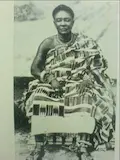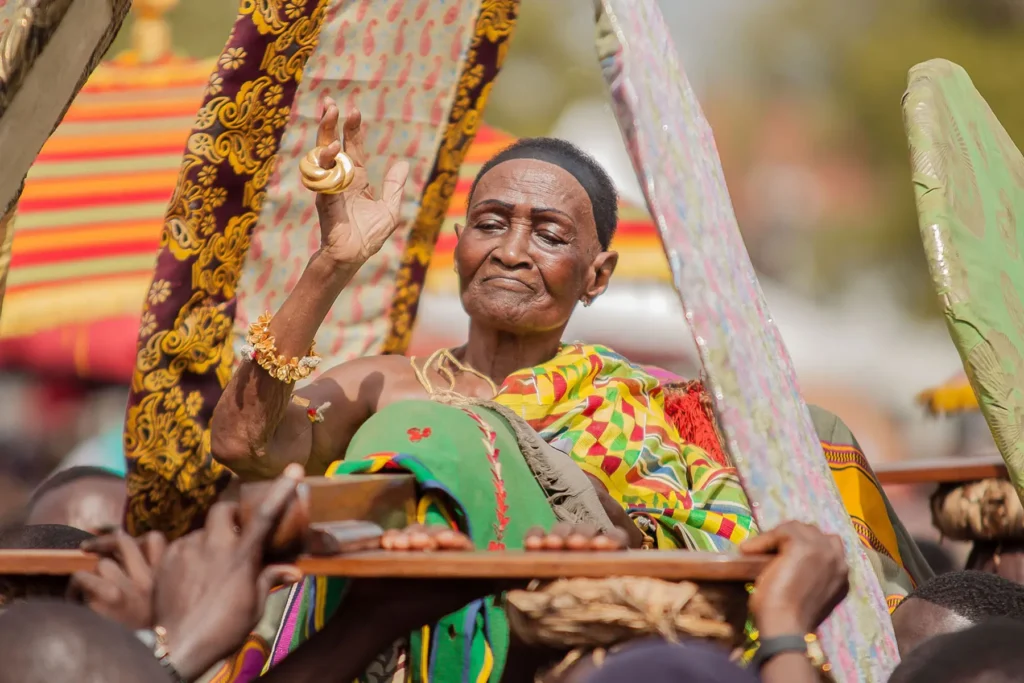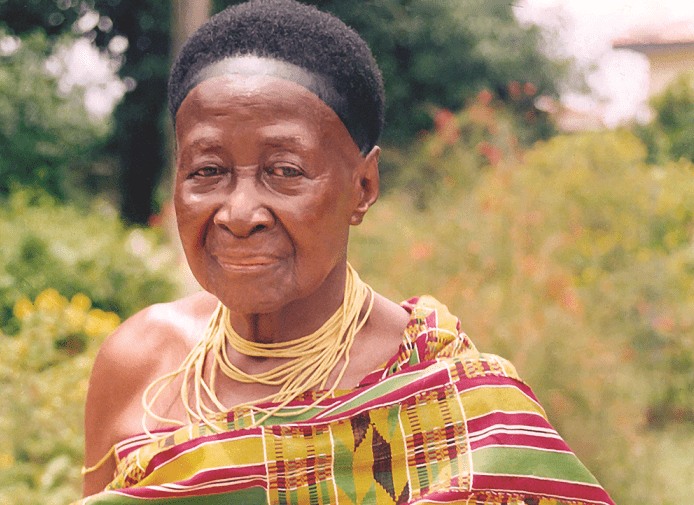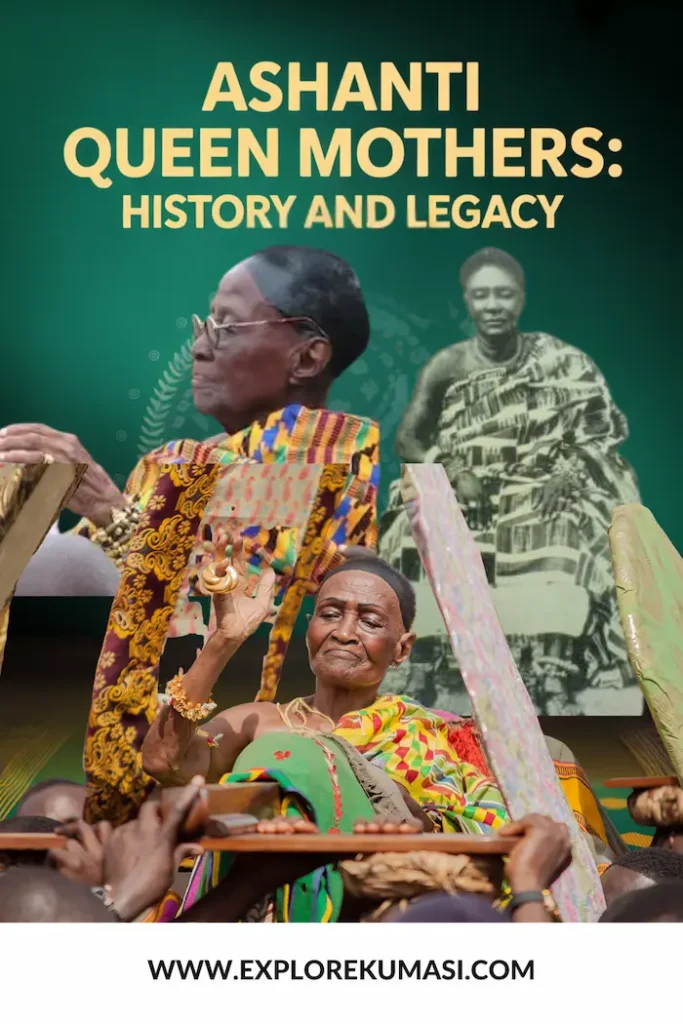Nana Ama Konadu Yiadom III and the Powerful Legacy of Ashanti Queen Mothers (1695–Present)

The Ashanti Kingdom follows a matrilineal system, in which inheritance, leadership, and royal identity are passed through the mother’s line.
This structure makes the Ashanti Queen Mother, known as the Asantehemaa, one of the most important figures in the kingdom.
While many people are familiar with the Asantehene, the king of the Ashanti Kingdom, fewer understand the depth of the Asantehemaa’s influence.
She is a political leader, cultural guardian, and key decision-maker whose voice has shaped Ashanti life for centuries.
This post outlines the lineage of the Asantehemaa from 1695 to the present, explaining the traditions, responsibilities, and leadership that define this royal position.

Struggling to Keep Track of All Your Kumasi Adventures? No worries!
With so much to see, do, and learn in Kumasi, it’s easy for the details to get lost. Want to make the most of your explorations? Then you need this FREE Kumasi Journal Set!
It’s perfect for recording your favorite spots, and cultural experiences, and even learning key Twi words and phrases to deepen your connection to Kumasi. Whether you’re a local or a visitor, this journal makes every moment count.
The Matrilineal Foundation of Ashanti Leadership
In the Ashanti Kingdom, power and family identity are passed down through the mother’s bloodline. This ensures that leadership remains within the royal family without disputes over legitimacy.
The Asantehemaa is at the center of this system. She protects the royal lineage, advises the king, and actively participates in governance.
Her position is not symbolic; she is a leader whose decisions influence both political and cultural life in Ashanti society.

Complete List of Asantehemaas (1695–Present)
For over 300 years, each Queen Mother has brought her own leadership style to the Ashanti Kingdom. Their reigns have guided the royal family through times of peace, conflict, and change.
The list below begins with the earliest confirmed Asantehemaa in historical accounts.
Chronological List:
- Nana Nyarko Kusiamoa (1695–1722)
- Nana Nkatia Abamo (1722–1740)
- Nana Akua Afriyie (1740–1768)
- Nana Konadu Yiadom I (1768–1809)
- Nana Akosua Adoma (1809–1819)
- Nana Ama Serwaa (1819–1828)
- Nana Yaa Dufie (1828–1836)
- Nana Afua Sapon (1836–1857)
- Nana Afua Kobi I (1857–1884)
- Nana Yaa Akyaa (1884–1917)
- Nana Konadu Yiadom II (1917–1945)
- Nana Ama Serwaa Nyarko (1945–1977)
- Nana Afia Kobi Serwaa Ampem II (1977–2016)
- Nana Ama Konadu Yiadom III (2016–Present)
While the Ashanti Kingdom’s history stretches back before 1695, records of earlier Queen Mothers are not formally documented.
If you are aware of names or family accounts passed down through oral history, please feel free to share them.

💡 Did You Know?
For the Asantehene, the Mamponghene acts as regent (Awisiahene) when the king passes away or is unable to rule, holding the fort until a new king is installed.
For the Asantehemaa, it is not the Mamponghemaa who takes on this regent role. Instead, it is the Kokofuhemaa who fills that position during a vacancy in the Queen Mother’s office, such as after her death or if she can no longer serve. This tradition helps maintain stability and continuity in the Ashanti royal structure.
Vacancies and Transitional Support
While this timeline appears continuous, brief vacancies have occurred between reigns due to periods of mourning or the time required to select a new Queen Mother. These are usually resolved through traditional consultations.
Nana Ama Konadu Yiadom III – Life and Legacy
Nana Ama Konadu Yiadom III was born in 1927 at Benyaade Shrine in Merdan, a small town in Kwadaso, Kumasi.
She was the daughter of Nana Afia Kobi Serwaa Ampem II, who served as Asantehemaa from 1977 to 2016, and Opanin Kofi Fofie, a respected carpenter from Besease near Atimatim in Kumasi.
Her reign connected two generations of Ashanti Queen Mothers and upheld the matrilineal traditions that guide royal leadership.
Following Ashanti custom, her passing was formally announced by Otumfuo during a meeting of the Asanteman Traditional Council on August 11, 2025.
Her life and service continue to be a symbol of dedication to the Ashanti Kingdom and its values. Damirifa Due Kotokohemaa!

Notable Anecdotes & Oral Traditions
Ashanti royal history is a blend of documented records and rich oral traditions passed down through generations.
While not every story can be verified in written archives, these accounts reflect the personality and leadership style of the Asantehemaas and remain part of the kingdom’s cultural memory.
📜 Documented Event
- Nana Konadu Yiadom I (1768–1809)
During her reign, the Asantehemaa’s stool was moved from Kokofu to Kumasi by Asantehene Osei Kwadwo. This relocation strengthened Kumasi’s position as the political and cultural center of the Ashanti Kingdom.
🗣 Oral Tradition
- Nana Afua Kobi I (1857–1880)
Oral accounts describe her as a firm and outspoken leader. One popular story claims that when British Governor Sir Garnet Wolseley spoke of claiming the Ashanti Empire for the Gold Coast Colony, she allegedly said she would slap him with her left hand, a bold symbol of defiance.
Although this statement is not found in official colonial archives, it remains a part of Ashanti oral history as an example of her fearless nature.
Ashanti history is filled with leaders remembered for their no-nonsense leadership style. Yaa Asantewaa of Ejisu is the most internationally recognized example, but many Asantehemaas have also been honored for their courage and outspokenness.
Places Named for Asantehemaas
Across Ashanti, several schools and institutions carry the names of past Asantehemaas, preserving their legacy in education and community life.
- Yaa Akyiaa Girls’ Basic School (Kumasi). Established in 1903 and renamed Yaa Akyiaa Girls’ School in 1912 in honor of an Asantehemaa. The school has served girls in Ashanti for over a century.
- Serwaa Nyarko Girls’ SHS (Kumasi). Named after Asantehemaa Nana Serwaa Nyarko, as recorded by the school itself.
- Afia Kobi Ampem Girls’ SHS (Trabuom). Formerly Atwimaman Secondary School. Renamed in the 2002/2003 academic year to honor Nana Afia Kobi Serwaa Ampem II.
- Konadu Yiadom SHS (Asamang). The school bears the Asantehemaa stool name Konadu Yiadom. Official listings confirm the school, although public records do not specify which queen mother the name refers to.
How the Asantehemaa Is Chosen
The Asantehemaa must come from the Oyoko royal clan, the same as the Asantehene. Her selection is based on bloodline, integrity, wisdom, and deep knowledge of Ashanti customs.
Respected elders and royals from the rightful lineage lead the selection. The Kokofuhemaa and Kenyasihemaa play essential roles in these discussions, along with other respected elders and lineage heads.
Their combined guidance guarantees the choice reflects both tradition and the needs of the kingdom. The steps move from family consultations to broader input from respected royals.
The Ashanti Traditional Council is informed and confirms that every stage fits with established tradition.
Although the Asantehemaa leads in choosing the next King, the Asantehene (Otumfuo) also plays a significant role in selecting the Queen Mother, reflecting the close balance of authority in Ashanti leadership.
💡 Did You Know?
Baffour Agyei Kesse IV, our current Adumhene, serves as the personal protector of the Asantehemaa. This role reflects a direct responsibility for her safety and the preservation of her authority within the Ashanti Kingdom.
The Asantehemaa’s Role as Kingmaker
When an Asantehene (King) passes away or is removed, the Asantehemaa selects a successor from the Oyoko matrilineage.
The selection process considers leadership qualities, respect for tradition, and the ability to unite the kingdom.
In 1999, Nana Afia Kobi Serwaa Ampem II played this role when her son, now Otumfuo Osei Tutu II, ascended to the Golden Stool.
While other names may have been discussed, he was ultimately chosen and enstooled as Asantehene.
The nominees are reviewed by the Kingmakers, who consist of senior chiefs and elders holding high-ranking positions within the Ashanti Kingdom.
They ensure the choice aligns with tradition, leadership needs, and the values of the Golden Stool.
The Asantehemaa (Queenmother) also has the authority to initiate the process of removing (destooling) a king who fails in his duties, provided the Kingmakers and other senior elders support the decision.

Cultural and Spiritual Leadership
The Asantehemaa plays a central role in preserving Ashanti customs. She leads and participates in major festivals such as Akwasidae, working closely with priests and elders to maintain sacred rites.
Through her involvement in these ceremonies, she strengthens the connection between present-day Ashanti people and their heritage, encouraging unity and cultural pride.
Ceremonial Appearance
During major festivals and processions, the Asantehemaa is carried in a special palanquin called an Apakan. It is lifted on the heads of men, showing the honor and respect given to her role.
The Asantehene is carried differently, on the shoulders of men, which reflects his authority.
Together, these traditions highlight the distinct but complementary positions of the King and Queen Mother in Ashanti leadership.
Voice for Women and Families
The Asantehemaa is the highest-ranking queen mother in Asanteman and is regarded as the head of women in the Ashanti Kingdom.
While many towns and divisions have their own queen mothers, she stands above them all, representing women at the highest level of leadership.
She makes sure women’s voices are included in matters of tradition, politics, and community welfare.
She listens to concerns from other queen mothers across the Ashanti region and brings these perspectives into royal decisions.
Traditionally, all markets in Asanteman fall under the authority of the Asantehemaa.
Since markets are central to women’s roles in trade and community life, this reflects her close connection to the daily lives of Ashanti families and her influence in both social and economic matters.
She also mediates disputes, particularly those involving inheritance or family matters, earning trust through her fairness and deep knowledge of custom.
Matrilineal Succession and Authority
In Ashanti tradition, leadership is passed down through the mother’s line, which gives the Asantehemaa a unique responsibility in protecting the royal future.
Beyond simply confirming bloodlines, she maintains detailed knowledge of family ties and past successions.
This knowledge prevents disputes over eligibility for the Golden Stool and sees to it that new leaders are chosen from the rightful lineage.
It also helps guide younger royals in understanding their heritage and their role in the kingdom’s history.
Naming Traditions of the Asantehemaa
Upon becoming Asantehemaa, she takes a stool name that reflects her role and honors Ashanti royal tradition. The Asantehene follows the same custom at his enstoolment.
More than one queen mother has used some stool names as a way to connect with the respected leadership of the past.
For example, Konadu Yiadom has appeared more than once in Ashanti history, symbolizing continuity and a connection to earlier Asantehemaas who carried that name.
The current Queen Mother, Nana Ama Konadu Yiadom III, continues this tradition, linking her reign to the heritage of those before her while guiding the kingdom in modern times.
Yaa Asantewaa Was Not an Asantehemaa
Looking at the above list of Asantehemaas, you might be wondering, where is Yaa Asantewaa?
It is often believed that she once held the title of Asantehemaa, but this is not correct. Yaa Asantewaa was the Queen Mother of Ejisu, a critical state within the Ashanti Confederacy.
In 1900, she led the War of the Golden Stool, standing against British demands for this sacred royal symbol. Her courage and leadership made her a legendary figure in Ashanti history, despite her position being regional rather than kingdom-wide.
Enjoying This Post? Keep Exploring With Us!
If this post connects with you, check out our store for fun and interactive ways to explore Kumasi, the Ashanti Kingdom, and the Ashanti Region. From history and culture to beginner-friendly Twi language learning, we’ve created resources to help you learn, connect, and share.

The Asantehemaa is a leader, advisor, and guardian of Ashanti tradition. Her role combines political influence, cultural preservation, and spiritual guidance.
Through centuries of leadership, the Queen Mothers of the Ashanti Kingdom have ensured that the matrilineal heritage remains strong, the Golden Stool remains protected, and the values of the Ashanti people endure.
Looking at the timeline of Asantehemaas, how many have you known in your lifetime? Please share your memories or what you’ve heard about them; every story keeps this history alive.
Common Questions About the Asantehemaa’s Role
Does she rule over other Queen Mothers?
Yes. The Asantehemaa is the highest-ranking queen mother in the Ashanti Kingdom and is respected by all others.
Is there always an Asantehemaa in place?
Not always. Vacancies can occur during transitions, and during these times, the Kokofuhemaa may step in as regent during the vacancy.
Is the Asantehemaa higher than the Asantehene?
No. The Asantehemaa is not higher than the Asantehene, but she holds equal spiritual authority in many matters and is deeply respected.
Can a Queen Mother be destooled?
Yes. If she breaks her oath or loses the confidence of the elders, she can be removed.
Is there only one Queen Mother in the Ashanti Kingdom?
No. Many traditional areas have their own queen mothers, but the Asantehemaa is the highest-ranking queen mother in Asanteman and is respected across the kingdom.
What’s her role in modern times?
She continues to lead women’s groups, promote education, and preserve Ashanti customs in both civic and traditional spaces.
AKWAABA!! IF THIS POST CAPTURED YOUR ATTENTION, KEEP EXPLORING KUMASI WITH US AT ExploreKumasi.com. Yɛdaase!
You’ll find cultural guides, historical insights, and travel resources to help you experience Kumasi and the Ashanti Region more deeply.
💬 Want to stay connected? Join our community on Facebook to share your thoughts and discoveries.
📌 Inspired by what you read? Pin an image to come back later or share with someone planning their own Kumasi journey.
Thank you for exploring with us.









